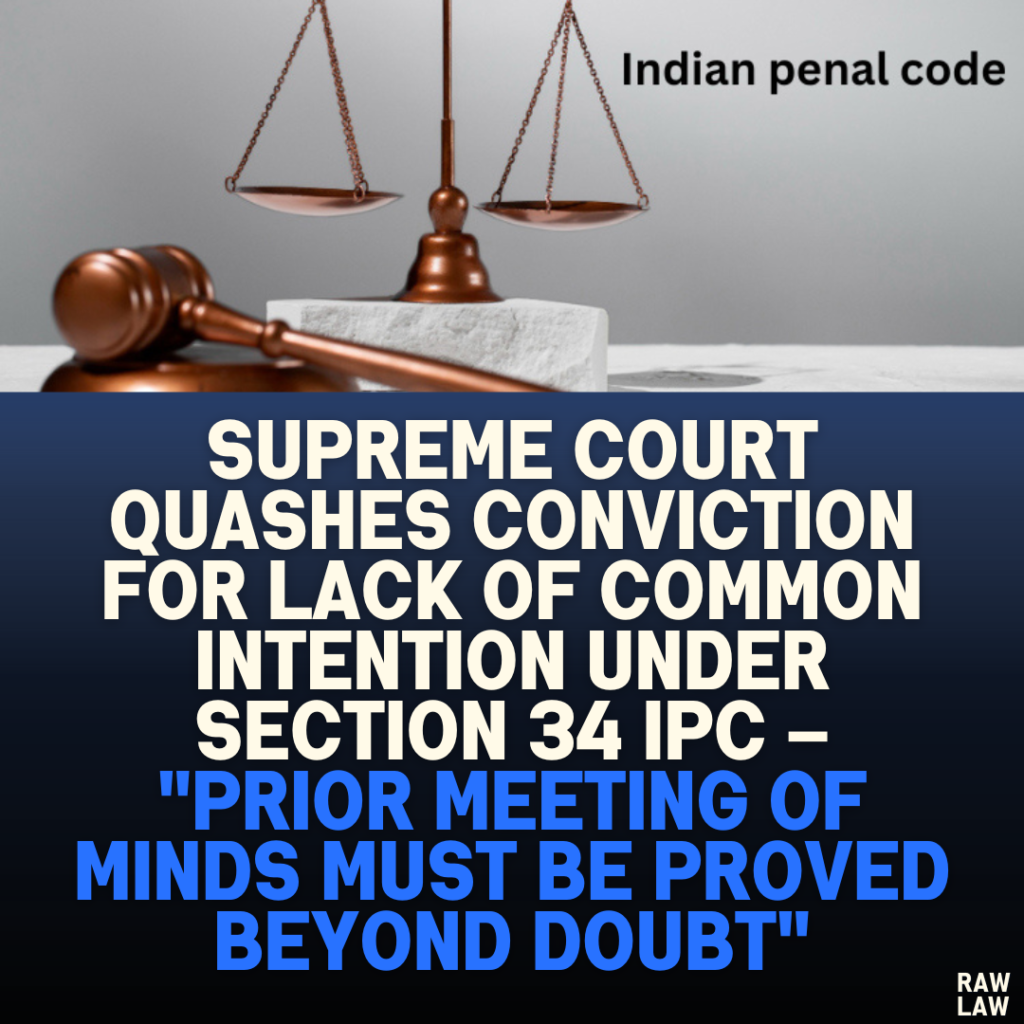Court’s Decision:
The Supreme Court overturned the Uttarakhand High Court‘s decision convicting three police personnel for murder with the aid of Section 34 IPC. The court restored the trial court’s acquittal, holding that the prosecution had failed to prove that the appellants had a shared common intention with the head constable, who fired the fatal shot.
Facts:
- Incident:
- On November 15, 2004, police received information about a car smuggling illegal liquor.
- A team of police officers, including Head Constable Jagdish Singh and three other appellants, pursued the suspect car in an unmarked vehicle.
- When the car failed to stop, Jagdish Singh fired a shot, which struck the deceased (a woman passenger) and caused her death.
- Complaint:
- The deceased’s husband, who was driving the car, filed a written complaint against Jagdish Singh and unnamed police constables.
- A First Information Report (FIR) was registered under Section 302 IPC.
- Trial Court’s Decision:
- The trial court convicted Jagdish Singh of murder and sentenced him to life imprisonment.
- The three other police personnel were acquitted due to insufficient evidence proving their involvement in a common intention.
- High Court’s Decision:
- The High Court reversed the acquittal of the three appellants, holding that their presence in the car with Jagdish Singh was sufficient to establish a common intention.
- Supreme Court’s Intervention:
- The appellants challenged the High Court’s ruling, leading to the Supreme Court’s review.
Issues:
- Whether the three appellants shared a common intention with Jagdish Singh to commit murder, warranting their conviction under Section 34 IPC.
- Whether the High Court was justified in overturning the trial court’s acquittal of the appellants.
Petitioner’s Arguments:
- Lack of Evidence for Common Intention:
- The appellants argued that no evidence demonstrated they shared a common intention with Jagdish Singh to kill the deceased.
- Their mere presence in the car was insufficient to prove shared intent.
- Unwarranted High Court Interference:
- The appellants highlighted that the trial court had acquitted them based on reasoned findings, and there was no perversity in those findings to justify interference.
- Legal Precedents:
- The petitioners relied on Supreme Court rulings, such as Gadadhar Chandra v. State of West Bengal, which require strong evidence of a prior meeting of minds to convict under Section 34 IPC.
Respondent’s Arguments:
- The respondent-State defended the High Court’s judgment, asserting that the appellants’ presence in the car with the shooter demonstrated shared intent.
- The prosecution emphasized that the act of accompanying Jagdish Singh in an official vehicle implied their complicity.
Analysis of the Law:
- Section 34 IPC:
- Section 34 IPC requires the prosecution to prove a “common intention” among all accused to commit a crime.
- Common intention involves a prior meeting of minds and a shared purpose to execute the criminal act.
- Scope of Appellate Review:
- The court reiterated principles for overturning acquittals:
- Acquittal strengthens the presumption of innocence.
- An appellate court can only interfere if the trial court’s decision is perverse, unreasonable, or based on a misreading of evidence.
- The High Court’s power to overturn acquittals is limited to cases where no two reasonable views are possible.
- The court reiterated principles for overturning acquittals:
- Precedents:
- The court relied on judgments like Ezajhussain Sabdarhussain v. State of Gujarat and Gadadhar Chandra v. State of West Bengal, which emphasize that a mere association or presence with the primary accused is not sufficient to prove common intention.
Precedent Analysis:
The court referred to landmark rulings to underline the principles governing Section 34 IPC:
- Prior Meeting of Minds:
- Prosecution must establish that the accused planned the crime together or consciously participated in it.
- Acquittal Appeals:
- Double presumption of innocence applies in acquittal cases, and appellate courts must exercise restraint.
Court’s Reasoning:
- Trial Court’s Findings:
- The trial court acquitted the appellants, noting:
- The three accused were acting under the command of their superior officer (Jagdish Singh).
- No evidence showed they shared a common intention to fire the fatal shot.
- Identification evidence against the appellants was weak and based on a single witness.
- The trial court acquitted the appellants, noting:
- High Court’s Errors:
- The High Court relied solely on the appellants’ presence in the vehicle to infer common intention, without concrete evidence.
- The Supreme Court noted that this reasoning was flawed, as mere presence is insufficient to convict under Section 34 IPC.
- Supreme Court’s Conclusion:
- There was no evidence of a prior meeting of minds or a shared intent among the appellants and Jagdish Singh.
- The prosecution failed to meet the high standard of proof required for Section 34 IPC.
Conclusion:
- The Supreme Court allowed the appeals and restored the trial court’s acquittal of the appellants.
- It quashed the High Court’s judgment, holding that the evidence was insufficient to prove the appellants shared a common intention with Jagdish Singh.
Implications:
- This judgment reinforces the principle that criminal liability under Section 34 IPC cannot be inferred from mere association or presence.
- It underscores the appellate courts’ responsibility to respect trial court findings unless clear perversity is demonstrated.




Pingback: Bombay High Court Imposes Rs. 5 Lakhs Penalty for Defendant’s Failure to Comply with Injunction Order: "Defendant’s Contumacious Conduct in Withholding and Deleting Sensitive Data Warrants Civil Penalty" - Raw Law